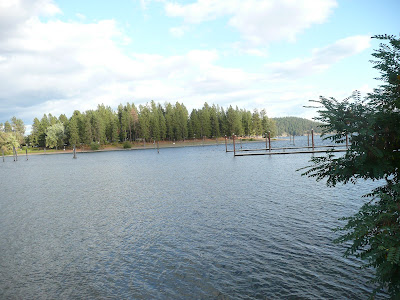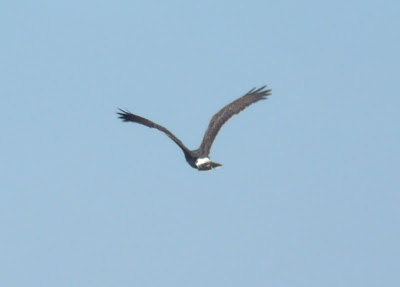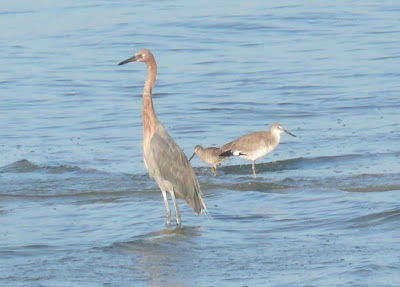Saw my FOS Yellow-rumped Warblers here in Florida today on a visit to Six-Mile Cypress Slough. But they were not actually the first that I saw this month, as these were the commonest warblers I encountered on my vacation to Eastern Washington and the Idaho Panhandle a few weeks ago. The vacation was new ground for me and offered a lot of opportunity for lifers like Common Ravens and Great White-Fronted Geese. Other lifers I was able to add included American Pipits, Black-billed Magpies, Western Meadowlark, Western Bluebird, Mountain Chickadee, California Quail, Western Grebe, Pygmy Nuthatch and Red-Breasted Nuthatch. I did not find all the targeted birds on my list like Baird's plover or horned lark, but I can't complain. My best sighting was the family of Trumpeter Swans living at Turnbull National Wildlife Refuge near Cheney, Washington. Beautiful birds and had a great show as they flew overhead in their vee formation
Had high hopes for a rewarding fall migration, but the pickings were slim in our corner of Florida. Few warblers, no thrushes or tanagers, and only the only oriole was an orchard oriole seen in September. The Hawk Watch event that was scheduled on October 17th as a kick-off for Ding Darling days on Sanibel Island was disappointing with low counts too. Did have a few Kestrels, Merlins, Sharp-shined Hawks and a a couple of Northern Harriers. Though the hawks were few the Indigo Buntings, Painted Buntings, Blue Grosbeak and a Magnolia Warbler made up for it.
We also are watching in October for several of our wintering birds to arrive like House Wrens, Dunlins and Palm Warblers. As noted at the start I had my first-of-season Yellow-rump warbler today and other birders I met at Six-mile cypress slough today reported seeing blue-headed vireo and a couple of ruby-crowned kinglets. I did not see the vireo or kinglet, but they have arrived.
Following is a FOS listing for several species that winter in Lee County, Florida.
Belted Kingfisher - July
Red Knot - September 27th
Palm Warbler - October 2nd
Blue-winged Teal - October 3rd
Gray catbird - October 5th
House Wren - October 17th
Northern Harrier - October 17th
Indigo Bunting - October 17th
Painted Bunting - October 17th
Eastern Phoebe - October 18th
Wilson's Snipe - October 21st
American Coot - October 23rd
Dunlin - October 25th
Yellow-rumped Warbler - October 31
Ruby-crowned kinglet - October 31st
Blue-headed Vireo - October 31st
Other species I am still waiting on include ring-billed gulls, herring gull, yellow-bellied sapsucker, savanna and grasshopper sparrows and several ducks.
My October List - (165)
- Greater White-fronted Goose - Idaho
- Canada Goose - Washington & Idaho
- Trumpeter Swan - Washington
- Muscovy Duck (Domestic type) - Florida
- Wood Duck - Washington
- American Wigeon - Washington & Idaho
- Mallard - Washington & Idaho
- Mallard (Domestic type) - Florida
- Mottled Duck - Florida
- Blue-winged Teal - Washington & Florida
- Northern Pintail - Washington
- Canvasback - Idaho
- Ring-necked Duck - Washington & Idaho
- Lesser Scaup - Washington & Idaho
- Bufflehead - Washington & Idaho
- Common Merganser - Idaho
- Ruddy Duck - Washington & Idaho
- California Quail - Idaho
- Ring-necked Pheasant - Washington & Idaho
- Wild Turkey - Washington
- Pied-billed Grebe - Florida, Washington & Idaho
- Western Grebe - Idaho
- Brown Pelican - Florida
- Double-crested Cormorant - Florida, Washington & Idaho
- Anhinga - Florida
- Great Blue Heron - Florida, Washington & Idaho
- Great Egret - Florida
- Snowy Egret - Florida
- Little Blue Heron - Florida
- Tricolored Heron - Florida
- Reddish Egret - Florida
- Cattle Egret - Florida
- Green Heron - Florida
- Black-crowned Night-Heron - Florida
- Yellow-crowned Night-Heron - Florida
- White Ibis - Florida
- Glossy Ibis - Florida
- Roseate Spoonbill - Florida
- Wood Stork - Florida
- Black Vulture - Florida
- Turkey Vulture - Florida
- Osprey - Florida
- Snail Kite - Florida
- Bald Eagle - Florida
- Northern Harrier Florida, - Washington & Idaho
- Sharp-shinned Hawk - Idaho & Florida
- Cooper's Hawk - Washington & Florida
- Red-shouldered Hawk - Florida
- Red-tailed Hawk - Florida, Washington & Idaho
- Crested Caracara - Florida
- American Kestrel - Florida, Washington & Idaho
- Merlin - Florida
- Peregrine Falcon - Florida
- Common Moorhen - Florida, Washington & Idaho
- American Coot - Florida, Washington & Idaho
- Limpkin - Florida
- Sandhill Crane - Florida
- Black-bellied Plover - Florida
- Wilson's Plover - Florida
- Semipalmated Plover - Florida
- Piping Plover - Florida
- Killdeer - Florida & Idaho
- American Oystercatcher - Florida
- American Avocet - Florida
- Spotted Sandpiper - Florida
- Greater Yellowlegs - Florida & Washington
- Willet - Florida
- Lesser Yellowlegs - Florida
- Marbled Godwit - Florida
- Ruddy Turnstone - Florida
- Red Knot - Florida
- Sanderling - Florida
- Western Sandpiper - Florida
- Least Sandpiper - Florida
- Dunlin - Florida
- Short-billed Dowitcher - -Florida
- Long-billed Dowitcher - Idaho
- Wilson's Snipe - Florida
- Bonaparte's Gull - Idaho
- Laughing Gull - Florida
- Ring-billed Gull - Idaho
- California Gull - Idaho
- Common Tern - Florida
- Forster's Tern - Florida
- Royal Tern - Florida
- Sandwich Tern - Florida
- Black Skimmer - Florida
- Rock Pigeon Florida, - Washington & Idaho
- Eurasian Collared-Dove - Florida
- Mourning Dove - Florida, Washington & Idaho
- Common Ground-Dove - Florida
- Monk Parakeet - Florida
- Burrowing Owl - Florida
- Barred Owl - Florida
- Ruby-throated Hummingbird - Florida
- Belted Kingfisher - Florida & Idaho
- Red-headed Woodpecker - Florida
- Red-bellied Woodpecker - Florida
- Downy Woodpecker - Florida & Washington
- Hairy Woodpecker - Washington
- Red-cockaded Woodpecker - Florida
- Northern Flicker - Florida, Idaho & Washington
- Pileated Woodpecker - Florida
- Eastern Phoebe - Florida
- Say's Phoebe - Idaho
- Great Crested Flycatcher - Florida
- Loggerhead Shrike - Florida
- Northern Shrike - Washington
- White-eyed Vireo - Florida
- Blue Jay - Florida
- Florida Scrub-Jay - Florida
- Black-billed Magpie - Washington & Idaho
- American Crow - Washington, Idaho & Florida
- Fish Crow - Florida
- Common Raven - Washington & Idaho
- Northern Rough-winged Swallow - Florida
- Barn Swallow - Florida
- Black-capped Chickadee - Washington & Idaho
- Mountain Chickadee - Washington
- Tufted Titmouse - Florida
- Red-breasted Nuthatch - Washington & Idaho
- Pygmy Nuthatch - Washington
- Brown-headed Nuthatch - Florida
- Carolina Wren - Florida
- House Wren - Florida
- Marsh Wren - Washington
- Blue-gray Gnatcatcher - Florida
- Golden-crowned Kinglet - Washington
- Ruby-crowned Kinglet - Washington & Idaho
- Eastern Bluebird - Florida
- Western Bluebird Washington & Idaho
- American Robin - Washington & Idaho
- Gray Catbird - Florida
- Northern Mockingbird - Florida
- European Starling - Washington, Idaho & Florida
- American Pipit - Idaho
- Cedar Waxwing - Idaho
- Northern Parula - Florida
- Magnolia Warbler - Florida
- Yellow-rumped Warbler - Washington, Idaho & Florida
- Yellow-throated Warbler - Florida
- Pine Warbler - Florida
- Prairie Warbler - Florida
- Palm Warbler - Florida
- Black-and-white Warbler - Florida
- American Redstart - Florida
- Common Yellowthroat - Florida
- Eastern Towhee - Florida
- Chipping Sparrow - Idaho
- Song Sparrow - Idaho
- White-crowned Sparrow - Washington & Idaho
- Dark-eyed Junco - Washington & Idaho
- Northern Cardinal - Florida
- Blue Grosbeak - Florida
- Indigo Bunting - Florida
- Painted Bunting - Florida
- Red-winged Blackbird - Washington & Florida
- Eastern Meadowlark - Florida
- Western Meadowlark - Washington
- Common Grackle - Florida
- Boat-tailed Grackle - Florida
- Brown-headed Cowbird - Washington
- House Finch - Washington
- American Goldfinch - Idaho & Washington
- House Sparrow - Washington & Florida





















































